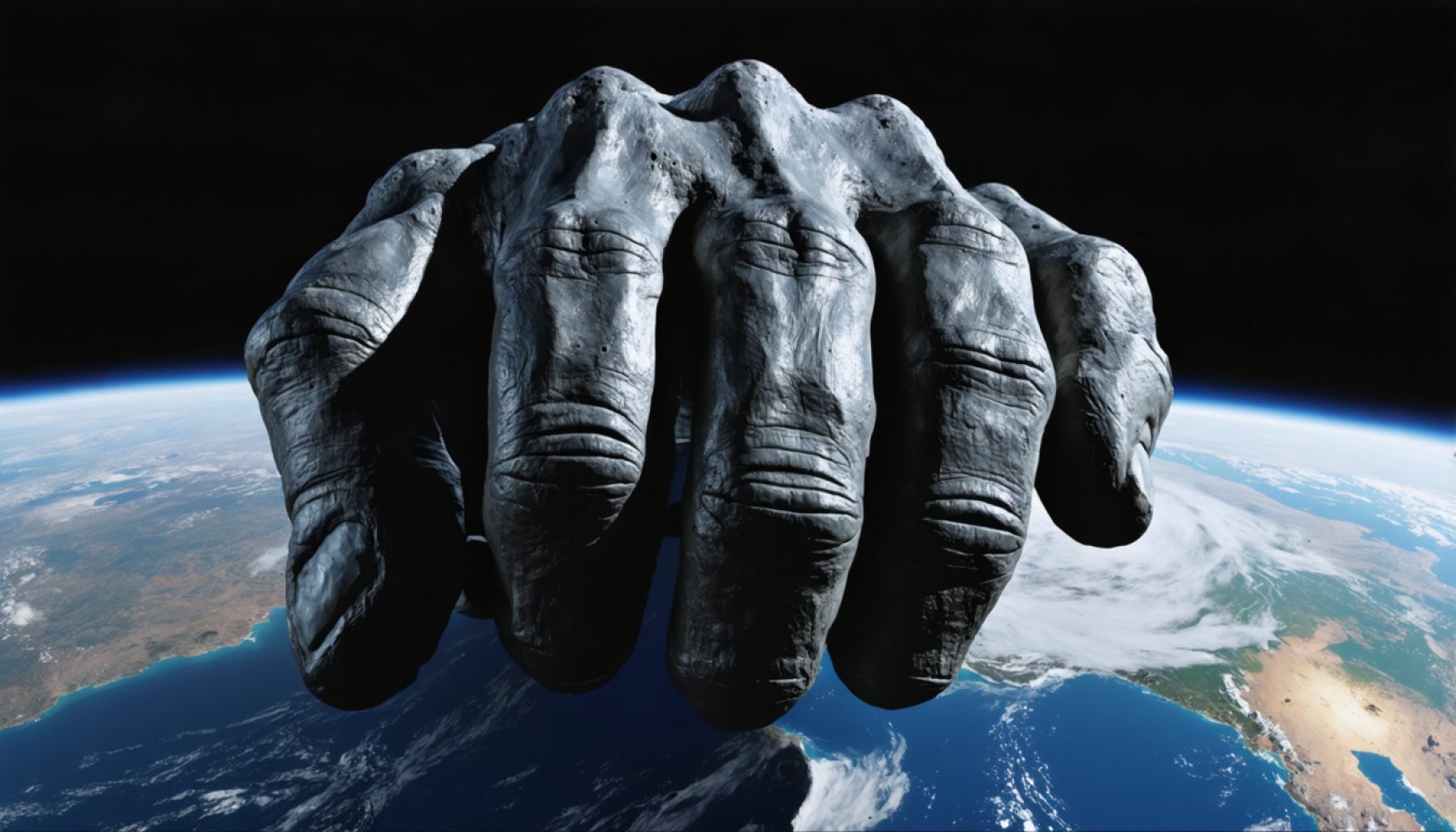
This image was generated using artificial intelligence. It does not depict a real situation and is not official material from any brand or person. If you feel that a photo is inappropriate and we should change it please contact us.
Prepare Your Knuckles: The Asteroid That Keeps Earth On Its Toes
- Asteroid 2024 YR4, dubbed the “scariest,” has captured global attention with its potential Earth impact in 2032.
- NASA initially estimated a 3.1% chance of collision, later revised to 1.5%, causing fluctuating anxiety levels.
- YR4’s size, between 40-90 meters, could devastate entire cities, reminiscent of the 1908 Tunguska event.
- The asteroid’s speed reaches 38,000 mph, evoking both emergency preparations and philosophical musings.
- NASA’s DART mission success bolsters hope that altering an asteroid’s trajectory is feasible.
- Humanity’s resilience, fueled by innovation and determination, remains a key theme in mitigating astronomical threats.
The cosmic ballet never stops, and currently, it’s being conducted by 2024 YR4, the “scariest” asteroid skimming past headlines and through nervous dreams worldwide. It promises uncertainty and whispers of doomsday, like a celestial trickster. Last week, it dangled fate like a capricious marionette, with NASA’s calculations offering a 3.1% chance of Earth-bound calamity in 2032 — enough to stir the pots of anxiety. Yet, a mere day later, fresh data rolled in, softening its blow with a more comforting 1.5%. Deep breaths, anyone? Perhaps not just yet.
Forecasted between 40 and 90 meters wide, YR4 poses a significant threat — the kind that can raze a metropolis and leave haunting ripples like the infamous Tunguska event of 1908. Such imagery demands reflection; should it embrace London in a fierce kiss, nearby towns like Slough could find windows shattered, echoing silent, glassy gasps.
Contemplating the asteroid’s approach, one might borrow from the whimsical panic seen in fiction — the dilemma of choosing the pub or the church. As the asteroid hurdles at a blistering 38,000 mph, some may lean towards stockpiling canned goods and crafting escape plans, while most will sip life with the steady calm of those resolved to weather tomorrow’s troubles another day.
Hope remains steadfast. NASA’s daring success with the DART mission inspires confidence; altering a rock’s orbit is within the realm of possibility. So, tuck away those apprehensions. To borrow from history and cinema, whether it’s “Deep Impact” destruction or “Armageddon” heroics, humanity has repeatedly shown its knack for survival, buoyed by innovation and spirit. After all, the show — beautifully, terrifyingly — must go on.
The Asteroid Conundrum: Navigating the Dance of the Cosmos with Insightful Tips and Predictions
How-To Prepare for Celestial Uncertainties
1. Stay Informed: Keep abreast of updates from reputable space agencies like NASA or the European Space Agency (ESA). Their websites frequently provide status updates on near-Earth objects.
2. Community Preparedness: Engage in local initiatives for disaster preparedness. While an asteroid impact is unlikely, such preparations often overlap with other emergencies like earthquakes.
3. Build a Safety Kit: Assemble a collection of essential items including water, non-perishable foods, a first-aid kit, flashlights, and important documents.
Real-World Use Cases
Space Agencies & Asteroid Defense: The DART mission by NASA is a significant real-world example of planetary defense. By successfully altering the orbit of a distant asteroid, NASA has demonstrated the technical capability to potentially divert hazardous objects heading towards Earth.
Market Forecasts & Industry Trends
Asteroid Mining Potential: As technology advances, the commercial benefits of asteroid mining are becoming more tangible. Companies like Planetary Resources have eyed metallic-rich asteroids that could supply raw materials for Earth and space-based operations.
Emerging Space Economy: Interest in exploiting asteroid resources points to a burgeoning space economy, potentially worth trillions. This underscores the importance of developing policies for space resource management.
Reviews & Comparisons
Asteroid Tracking Technology: Compare current tracking technologies by NASA and international space agencies, noting accuracy improvements like the Near-Earth Object Wide-field Infrared Survey Explorer (NEOWISE).
Controversies & Limitations
Public Perception vs. Reality: Despite headlines, the vast majority of tracked asteroids pose no threat to Earth, which can lead to public skepticism or overstated fears. Effective science communication is vital.
Technological Challenges: While missions like DART are encouraging, they are still in nascent stages. Enhancing our response capabilities involves significant technical and financial resources.
Features, Specs & Pricing
DART Mission Specs: The Double Asteroid Redirection Test (DART) spacecraft was equipped with a collision body and took around $330 million to develop, launch, and operate.
Security & Sustainability
Space Security: Planetary defense strategies are a component of global security discussions. Coordinated international efforts are crucial to building a resilient response system.
Sustainability in Space Exploration: There’s a growing focus on sustainable practices in space missions, focusing on minimizing space debris and encouraging international collaboration.
Insights & Predictions
Continued Technological Advancements: Expect further developments in detection systems and international collaboration to solidify Earth’s asteroid defense strategies.
Policy Development: Anticipate greater involvement from international bodies to create regulatory frameworks for aerospace activities and space resource utilization.
Pros & Cons Overview
Pros:
– Advanced asteroid tracking can prevent existential threats.
– Potential for resource extraction from asteroids.
– Increased innovation in aerospace technologies.
Cons:
– High costs and technological barriers.
– Potential for misinformation or exaggerated panic.
– Policy and ethical concerns related to space resource extraction.
Conclusion: Actionable Recommendations
Quick Tips:
– Follow Nasa’s website for real-time asteroid tracking updates.
– Participate in community preparedness programs.
– Advocate for science education to better understand cosmic events.
The celestial ballet continues, but with knowledge and preparedness, humanity stands ready to turn cosmic challenges into triumphs of ingenuity and resilience.